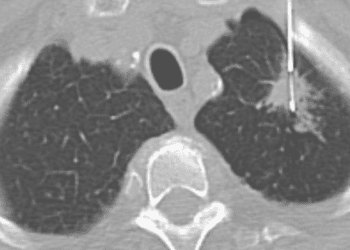Characterization of cancer development risk following pediatric radiation exposure from computed tomography
Evidence rating level: 3 (Average)
1. Exposure to a higher cumulative number of pediatric CT scans is associated with a greater risk of developing intracranial tumours, leukemia, and non-Hodgkin lymphoma.
2. Participants with 4 or more CT scans at or before age 6 had the greatest risk of developing cancer.
Study Rundown: Low-dose radiation is known to be oncogenic, and exposure to diagnostic CT is associated with greater cancer risk in both adults and children. Previous studies have not addressed whether the risk of developing cancer is influenced by the age of CT exposures or the cumulative number of CT scans. This population-based, nested case-control study aimed to determine whether radiation exposure from CT at or before age 18 increases the risk of developing intracranial tumours, leukemia, or lymphoma. It was determined that exposure to one pediatric CT scan did not increase cancer risk, but participants with 2-3 pediatric CT scans were at increased risk of developing intracranial tumours. Participants with 4 or more pediatric CT scans were at an increased risk of developing intracranial tumours, leukemia, and non-Hodgkin lymphoma. Furthermore, participants with 4 or more CT scans at or before the age of 6 were at the greatest risk of developing cancer. Overall, this study found a positive relationship between the cumulative number of pediatric CT scans and the development of intracranial tumours, leukemia, and non-Hodgkin lymphoma, as well as a positive association between younger age at the time of CT exposure and malignancy risk. Study findings highlight the importance of the judicious use of CT scans in the pediatric population, recognizing that the benefits of diagnostic imaging must be weighed against the risks of oncogenic radiation exposure.
Click here to read the study in CMAJ
Study Rundown In-Depth [nested case control]: Data was collected from the National Health Insurance Research Database (NHIRD) in Taiwan. The control population included all NHRID beneficiaries under the age of 25 between January 1, 2000, and December 31, 2013. The case population included those with intracranial tumours, leukemia, or lymphomas diagnosed during this study period. Patients with known cancer-predisposing conditions or malignancies diagnosed prior to the study period were excluded from this analysis. Controls (n = 78,057) were matched to cases (n = 7807) at a 10:1 ratio, based on sex, date of birth, and cohort entry date. Exposure to one pediatric CT scan did not increase cancer risk. Participants with 2-3 pediatric CT scans had an increased risk of developing intracranial tumours (adjusted OR 2.36, 95% CI 1.40-3.97), but no increased risk of leukemia or lymphoma. Participants with 4 or more pediatric CT scans were at increased risk of developing intracranial tumours (adjusted OR 9.01, 95% CI 2.89-28.11), leukemia (adjusted OR 4.80, 95% CI 1.79-12.84), non-Hodgkin lymphoma (adjusted OR 6.76, 95% CI 1.91-23.96), but not Hodgkin lymphoma (adjusted OR 3.61, 95% CI 0.37-35.08). The age of CT exposure was also found to impact cancer risk. Participants exposed to 4 or more CT scans at or before the age of 6 had the highest cancer risk, (adjusted OR 22.95, 95% CI 5.93-88.81), followed by ages 7-12 (adjusted OR 5.69, 95% CI 1.67-19.46), and then ages 13-18 (adjusted OR 3.20, 95% CI 1.27-8.06). p < 0.001 for this trend. Overall, this study emphasizes the importance of considering the risks associated with diagnostic imaging involving radiation, especially when caring for pediatric populations.
Image: PD
©2023 2 Minute Medicine, Inc. All rights reserved. No works may be reproduced without expressed written consent from 2 Minute Medicine, Inc. Inquire about licensing here. No article should be construed as medical advice and is not intended as such by the authors or by 2 Minute Medicine, Inc.

![2 Minute Medicine: Pharma Roundup: Price Hikes, Breakthrough Approvals, Legal Showdowns, Biotech Expansion, and Europe’s Pricing Debate [May 12nd, 2025]](https://www.2minutemedicine.com/wp-content/uploads/2025/05/ChatGPT-Image-May-12-2025-at-10_22_23-AM-350x250.png)





